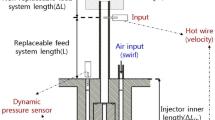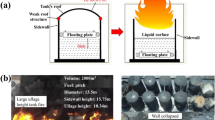Abstract
This study analyzes the effect of changes in input parameters on the prediction results in combustion instability. First, applying the centroid location of the flame shows higher accuracy of instability prediction than assuming that the flame is formed immediately after the injector. Also, the acoustic boundary of the recess inlet does not significantly affect the overall prediction result, but the acoustic boundary at the nozzle throat has such an effect that the instability frequencies are predicted completely differently. The gain of the flame transfer function is closely related to the strength of combustion instability, but less related to the overall tendency of combustion instability occurrence. However, a change in the flame transfer function phase changes whether combustion instability occurs at a specific frequency. Therefore, it is confirmed that the phase is a more important parameter than the gain of the flame transfer function in predicting combustion instability.
Similar content being viewed by others
Abbreviations
- c :
-
Sound speed
- f :
-
Frequency
- FTF:
-
Flame transfer function
- L :
-
Combustor length
- q :
-
Volume-integrated heat release rate
- u :
-
Oxygen velocity
- ω :
-
Modulation frequency
References
N. Demidovich, Launch Vehicle Failure Mode Database, COMSTAC RLV Working Group (FAA) 5 (2007).
T. Lieuwen, H. Torres, C. Johnson and B. Zinn, A mechanism of combustion instability in lean premixed gas turbine combustors, J. Eng. Gas Turbines Power, 123 (2001) 182–189.
N. Noiray, D. Durox, T. Schuller and S. Candel, A unified framework for nonlinear combustion instability analysis based on the flame describing function, Journal of Fluid Mechanics, 615 (2008) 139–167.
X. Han, J. Li and A. S. Morgans, Prediction of combustion instability limit cycle oscillations by combining flame describing function simulations with a thermoacoustic network model, Combustion and Flame, 162 (2015) 3632–3647.
K. T. Kim, H. J. Lee, J. G. Lee, B. Quay and D. Santavicca, Flame transfer function measurement and instability frequency prediction using a thermoacoustic model, ASME Turbo Expo 2009: Power for Land, Sea, and Air, Orlando (2009).
K. S. Kedia and A. F. Ghoniem, An analytical model for the prediction of the dynamic response of premixed flames stabilized on a heat-conducting perforated plate, Proceedings of the Combustion Institute, 34 (2013) 921–928.
L. Selle, G. Lartigue, T. Poinsot, R. Koch, K.-U. Schildmacher, W. Krebs, B. Prade, P. Kaufmann and D. Veynante, Compressible large eddy simulation of turbulent combustion in complex geometry on unstructured meshes, Combustion and Flame, 137 (2004) 489–505.
J. Li and A. S. Morgans, Time domain simulations of nonlinear thermoacoustic behaviour in a simple combustor using a wave-based approach, Journal of Sound and Vibration, 346 (2015) 345–360.
C. F. Silva, F. Nicoud, T. Schuller, D. Durox and S. Candel, Combining a Helmholtz solver with the flame describing function to assess combustion instability in a premixed swirled combustor, Combustion and Flame, 160 (2013) 1743–1754.
J. Yoon, High harmonic combustion instability characteristics of H2/CH4 fuel in a partially premixed combustor, Doctoral Dissertation, Seoul National University, Republic of Korea (2017).
J. H. Cho and T. Lieuwen, Laminar premixed flame response to equivalence ratio oscillations, Combustion and Flame, 140 (2005) 116–129.
B. C. Bobusch, B. Cosić, J. P. Moeck and C. Oliver Paschereit, Optical measurement of local and global transfer functions for equivalence ratio fluctuations in a turbulent swirl flame, Journal of Engineering for Gas Turbines and Power, 136(2) (2014) 021506.
B. Jones, J. G. Lee, B. D. Quay and D. A. Santavicca, Flame response mechanisms due to velocity perturbations in a lean premixed gas turbine combustor, Journal of Engineering for Gas Turbines and Power, 133(2) (2011) 021503.
S. G. Pater, J. B. Kok and T. H. van der Meer, Thermo acoustic flame transfer function prediction for turbulent non-premixed syngas flames, Turbo Expo: Power for Land, Sea, and Air (2006) 683–690.
S. A. Klein, On the acoustics of turbulent non-premixed flames, Doctoral Dissertation, Universität Twente, Netherlands (2000).
K. Balasubramanian and R. Sujith, Nonlinear response of diffusion flames to uniform velocity disturbances, Combustion Science and Technology, 180 (2008) 418–436.
A. Andreini, B. Facchini, A. Giusti and F. Turrini, Assessment of flame transfer function formulations for the thermoacoustic analysis of lean burn aero-engine combustors, Energy Procedia, 45 (2014) 1422–1431.
J. Eckstein and T. Sattelmayer, Low-order modeling of low-frequency combustion instabilities in aeroengines, Journal of Propulsion and Power, 22 (2006) 425–432.
B. Varoquié, J. Légier, F. Lacas, D. Veynante and T. Poinsot, Experimental analysis and large eddy simulation to determine the response of non-premixed flames submitted to acoustic forcing, Proceedings of the Combustion Institute, 29 (2002) 1965–1970.
A. Sengissen, J. Van Kampen, R. Huls, G. G. Stoffels, J. B. Kok and T. Poinsot, LES and experimental studies of cold and reacting flow in a swirled partially premixed burner with and without fuel modulation, Combustion and Flame, 150 (2007) 40–53.
K. P. Geigle, W. Meier, M. Aigner, C. Willert, M. Jarius, P. Schmitt and B. Schuermans, Phase-resolved laser diagnostic measurements of a downscaled, fuel-staged gas turbine combustor at elevated pressure and comparison to LES predictions, Journal of Engineering for Gas Turbines and Power, 129 (2007) 680–687.
W. Cheung, G. Sims, R. Copplestone, J. Tilston, C. Wilson, S. R. Stow and A. P. Dowling, Measurement and analysis of flame transfer function in a sector combustor under high pressure conditions, ASME Turbo Expo 2003 (2003) 187–194.
A. Gentemann, C. Hirsch, K. Kunze, F. Kiesewetter, T. Sattelmayer and W. Polifke, Validation of flame transfer function reconstruction for perfectly premixed swirl flames, ASME Turbo Expo 2004: Power for Land, Sea, and Air (2004) 501–510.
C. Paschereit, B. Schuermans, W. Polifke and O. Mattson, Measurement of transfer matrices and source terms of premixed flames, Journal of Engineering for Gas Turbines and Power, 124 (2002) 239–247.
S. Candel, D. Durox, T. Schuller, J.-F. Bourgouin and J. P. Moeck, Dynamics of swirling flames, Annual Review of Fluid Mechanics, 46 (2014) 147–173.
J. Bae, S. Jeong and Y. Yoon, Effect of delay time on the combustion instability in a single-element combustor, Acta Astronautica, 178 (2021) 783–792.
Y. Wang, C. H. Sohn, J. Bae and Y. Yoon, Prediction of combustion instability by combining transfer functions in a model rocket combustor, Aerospace Science and Technology, 119 (2021) 107202.
Acknowledgments
This work was supported by the National Research Foundation of Korea (NRF) grant funded by the Korea government (MSIT) (NRF-2021R1A2C2003759), the Korea government (MSIT) (2019M1A3A1A02076963), and the Korea government (MSIP) Space Challenge Project (2021M1A3B8075809) contracted through SNU Future Innovation Institute, and by the Institute of Advanced Aerospace Technology, SNU. The authors thank the anonymous reviewers for their many useful comments.
Author information
Authors and Affiliations
Corresponding author
Additional information
This paper is written based on the first author’s Ph.D. thesis.
**hyun Bae is currently a Post-doctor at the University of Toronto Institute for Aerospace Studies, Toronto, ON, Canada. He received his Ph.D. in Mechanical and Aerospace Engineering from Seoul National University. His research interests include combustion instability, acoustics, propulsion, and laser diagnostics.
Hyeontaek Jo is a Graduate School Student in Mechanical and Aerospace Engineering at Seoul National University, Seoul, Korea. His research interests include rocket injector, combustion instability, and laser diagnostics.
Youngbin Yoon is a Professor at the Department of Aerospace Engineering at Seoul National University, Seoul, Korea. He received his Ph.D. in Aerospace Engineering from University of Michigan. His research interests include liquid rocket engine, gas-turbine combustor, combustion instability, and laser diagnostics.
Rights and permissions
About this article
Cite this article
Bae, J., Jo, H. & Yoon, Y. Instability prediction of GO2/GCH4 flames in a single recessed coaxial injector using 1D lumped network model. J Mech Sci Technol 36, 5755–5764 (2022). https://doi.org/10.1007/s12206-022-1037-2
Received:
Revised:
Accepted:
Published:
Issue Date:
DOI: https://doi.org/10.1007/s12206-022-1037-2




